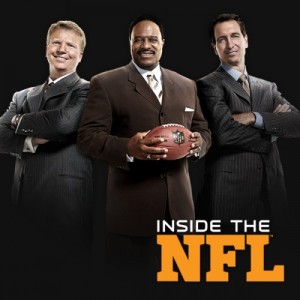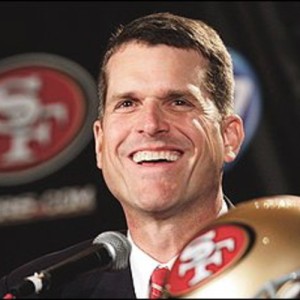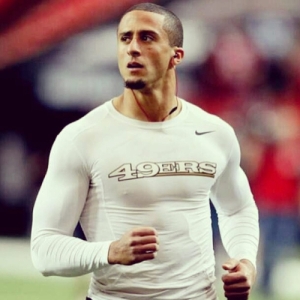Alright so… I’m a day late and a dollar short. It’s not because of a busy life, or anything of the sort. It’s because of the following three posts. I wrote the whole thing up and realized that I didn’t want something as unwieldy as my Wonder Woman piece, so I proceeded to split this into three parts and format them accordingly.
This blog is dedicated to the exploration of storytelling in all its forms, and today we’ll explore a form many of us take for granted: sports, the National Football League in particular. And it’s not necessarily the sport itself that tells the story, but the spectators around it. For those of us who spend their waking hours exploring the more intellectually rewarding mediums, we can scoff at the droves of men in tights as they put their wellbeing on the line for one inflated morsel of pigskin, and we can write it off as unworthy. But there’s more going on in one game than we expect. Character development, thematic elements, and subtext are abound. And this past year, during Superbowl XLVII, the San Francisco 49ers and the Baltimore Ravens clashed in the climax of a story none of us could have made up.
The Narrator
For me the most exciting element about the story of Superbowl XLVII, and sports in general, is how it’s told, and who is telling it. The concept of the narrator becomes an abstract entity that possesses your friends, or your family. The major networks and sports radio have had a long tradition of providing that narration in the form of commentary, naming players you may not know, giving you statistics that may come to play during the game, and perhaps adding their own opinion into the mix. Every fan has their favorite place to turn for their narrator, but my favorite by far is Showtime’s Inside The NFL. Unlike ESPN, who does an amazing job of accomplishing very little with the twenty four hours they have in a day, Inside The NFL strays from the traditional (and highly unappealing) sportscasting style. If you’re a lover of storytelling like me, you owe it to yourself to do the following.
- Record Inside The NFL when it resumes in the fall. Don’t watch it when it’s on. Don’t even watch a game on Sunday. Just find this show, and record it.
- When you have the time, play back an episode of this show, but don’t just watch it. As a story lover you need to do it a bit differently.
- Fast forward to the recaps. You’ll know when these start when you see two team logos side by side.
- Take in the cinematography, the masterful narration, and candid sound bites of players and coaches. Instead of the 15-30 second token recap of most other sports shows, these guys take a good 3-5 minutes per game, take from official footage from NFL Films, and they’re narrated by Scott Graham, who has an amazing voice. To be honest, I’m reluctant to call them recaps. They’re more like miniature documentaries with Hollywood cinimatography.
- Now enjoy the in depth and enlightening discussions between host James Brown, former wide receiver Cris Collinsworth, and former quarterback Phil Simms. Because this is on Showtime, there are no commercials, so the three of them and their guests can go more in depth. Their chemistry and banter is entertaining as well. Their interviews are also very intimate, and hard hitting. ESPN and the major networks are just now beginning to catch up.
Trust me. No one does it better than these guys. Now to set the stage.
The NFL Playoffs
At the end of every regular season, the twelve teams with the best record face off in a single elimination tournament lasting about one month until there are two teams left standing. These two teams will face of at the superbowl. It is here that our stage is set. Many of the teams who have made it to the playoffs this year have amazing stories of their own, like the Washington Redskins and their rookie quarterback, Robert Griffin III, who led them from having one of the worst records the year before to making it to the playoffs this year. It was a dramatic turnaround only matched by the Indianapolis Colts, who also had a rookie quarterback, Andrew Luck, who redeemed their team from an abysmal record in the previous year. What made the Colts story different was their coach, Chuck Pagano, who was diagnosed with cancer in the middle of the season, and gave a tear jerking speech that propelled them to the playoffs. Many people considered them the team to beat, if for nothing else, than their motivation. As we know, neither team made it to the Superbowl. A little more on them in part two of this article. Let’s talk about the two teams that did.
San Francisco 49ers
Bill Walsh, Head Coach 1979-1988I came to the San Francisco 49ers with a specific goal, to implement what I call the Standard of Performance. It was a way of doing things, a leadership philosophy, that has as much to do with core values, principles, and ideals as with blocking, tackling, and passing; more to do with the mental than with the physical.
Based in San Francisco, California, this team was founded in 1946 as a charter member of the All-America Football Conference (AAFC) and joined the NFL in 1949 after the two leagues merged. The 49ers have a legacy of one of the NFL’s greatest dynasties, winning five Super Bowl championships in just 14 years, between 1981 and 1994, with four of those championships in the 1980s. The Super Bowl teams were led by Hall of Famers Joe Montana, Jerry Rice, Ronnie Lott, Steve Young, and coach Bill Walsh. Those are some massive shoes to fill. With five Super Bowl wins, the 49ers are tied with the Dallas Cowboys for the second-most Super Bowl wins. What a legacy… and what pressure. An ownership change at the turn of the millennium saw turbulence at all levels in the organization, and the pressure became too much for those involved. For nearly a decade the 49ers were reduced from a Superbowl contender to a pushover. They were at the bottom of the ladder, in the back of the line, in a place they had never been before. After a series of bad choices on an off the field the organization made two key hires.
Coach Jim Harbaugh – If football were war, the Head Coach would be the general of an army. He chooses which soldiers to recruit, which captains to appoint, what weapons to use, how to engage the enemy (the opposing team), so on and so forth. These duties/liberties vary from organization to the next. But in San Fran the coach is a lynchpin, who receives far too little credit for the work he does. After more than a decade playing as a decent quarterback, Jim turned his aspirations towards coaching, beginning with a few assistant gigs around the league and in college football. He gained notoriety when he became head coach for Stanford (yes, that Stanford) and led them to success. The San Francisco 49ers tapped him for the 2011-12 season after firing Mike Singletary and interim coach Jim Tomsula, who led the team for (count em) one game. To add to the chaos, a players union lockout suspended off season activities until less than a month before the 2011-12 season began. So if this were war, Jim Harbaugh was appointed general of the San Francisco army after two generals had been fired, and he wasn’t able to train his troops until about a month before they went into war.
On top of the circumstances, we can add the man’s demanding personality. He’s known to be very good at getting under people’s skin. All around the league there are cornerbacks, weighing in at 250 lbs, who want to hurt the man, and cornerbacks are trained to catch and hurt people. His brother, John recalled their childhood during an interview with the Sacramento Bee.
“He would alienate the other kids, so I was really the only friend he had. We joke that dad’s profession was the perfect profession for Jim… We were in Iowa one time and dad felt bad because we were leaving for Michigan. He tried to break it to us, and Jim goes, ‘Just in time, dad. I just ran out of my last friend.’ “
In this same interview, John recalls one baseball game where a young Jim drilled a girl between the numbers because she was crowding the plate. I’m annoyed and amused all at once when Inside the NFL puts the mic on him. He’s like a combination of Coach Carter, Gregory House, and Sheldon Cooper. In spite of his challenging personality and the circumstances the NFL put him in, his team was unexpectedly successful, and in the 2012-13 season, he led them to the Superbowl. Of course, he had help.
Colin Kaepernick – Continuing the war analogy, if the coach is the general of an army, the quarterback is the captain of the Vanguard, and this captain was drafted into the 49ers the same year Harbaugh was hired. They were the two new kids on the block, but during the 2011-12 season, Colin was quiet. He was mostly relegated to the sidelines as he learned the ins and outs of a system that was in flux due to the fact that the general (Harbaugh) was just getting to know his troops. Alex Smith remained the quarterback for the majority of Colin’s first season in the NFL. It wasn’t until Alex Smith got injured halfway through the 2012-13 season that Colin was called up from the bench.
For those of you in the Carolinas, this was the same season we drafted Auburn quarterback Cam Newton to the Panthers. Newton was the first pick in the entire draft. Colin Kaepernick was pick #36. Newton’s started every game since he came to the Panthers (32 in all). Kaepernick has started ten games in the NFL… Including the Superbowl. There are rookies that came in the year after Colin who played more games than him. This is not speaking to the detriment of Cam or any of the other rookies, it’s more so speaking to the talent and circumstances surrounding Colin.
But how did a green quarterback, a newly appointed head coach, and a franchise on the mend defy the odds and make their way to the national championship in 2013? More on that, their opponents, and the outcome in the next two installments.





